The Kanazawa Doki Kaisha 金沢銅器会社
For taking part in the Vienna World's Fair 1873 as an official member, the Meiji government commissioned artisans including metal workers in Kanazawa for the exhibition. This governmental policy pushed artizans to establish the Kanazawa Doki Kaisha 金沢銅器会社 and the Kiryu Kosho Kaisha 起立工商会社, and the individual Ozeki Yahei 大関弥兵衛 to participate in the art export business.
In 1877 the Kanazawa Doki Kaisha (金沢銅器会社) was established in Naga-machi, Kanazawa-ku, Ishikawa-prefecture with the aim of assisting metalworkers and exporting new products overseas.
Koji Yamakawa 山川幸次 (1828-1882)
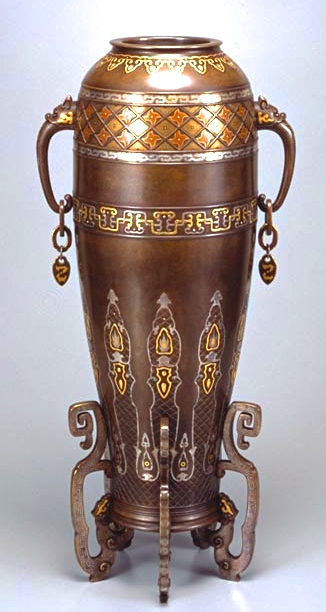 Gold and Silver Inlayed Vase 金銀象嵌環付花瓶 by Koji Yamakawa, circa 1877. Commissioned by the curio export maechnat Magohei Marunaka (圓中孫平 1830-1910). The same design piece was for the first national exhibition and this piece won the prize (鳳紋賞牌). And also the other same design piece was presented to a wife of the General Ulysses S. Grant by the Emperor when she visited Japan. The former piece exhibited at Paris Expo 1878 and won the Gold medal but it does not bear the signiture and intruduced as Ecchu Takaoka Doki 越中高岡銅器. This desgn was derived from the design book "温知図録" which the government prepared and rent for promoting the domestic industry during 1876-to 1886.Koji Yamakawa (山川孝次 1828-1882) was born in Kanazawa. He changed his name fro Yasokichi Yamaya 山屋八十吉 to Koji Yamakawa around early 1860s. He apprenticed to Harushige Yanagawa (柳川春茂) who belonged to a school of famous Soumin Yokoya (横谷宗珉) in Edo, He was called “Kaga Soumin (加賀宗珉)” because he rapidly acquired the skills and presented it on his works.
Gold and Silver Inlayed Vase 金銀象嵌環付花瓶 by Koji Yamakawa, circa 1877. Commissioned by the curio export maechnat Magohei Marunaka (圓中孫平 1830-1910). The same design piece was for the first national exhibition and this piece won the prize (鳳紋賞牌). And also the other same design piece was presented to a wife of the General Ulysses S. Grant by the Emperor when she visited Japan. The former piece exhibited at Paris Expo 1878 and won the Gold medal but it does not bear the signiture and intruduced as Ecchu Takaoka Doki 越中高岡銅器. This desgn was derived from the design book "温知図録" which the government prepared and rent for promoting the domestic industry during 1876-to 1886.Koji Yamakawa (山川孝次 1828-1882) was born in Kanazawa. He changed his name fro Yasokichi Yamaya 山屋八十吉 to Koji Yamakawa around early 1860s. He apprenticed to Harushige Yanagawa (柳川春茂) who belonged to a school of famous Soumin Yokoya (横谷宗珉) in Edo, He was called “Kaga Soumin (加賀宗珉)” because he rapidly acquired the skills and presented it on his works.
In 1862 he was employed as a official silversmith (白銀師) by the Kaga domain (加賀藩) .
He called on finest artisans in the Kaga domain for the exhibition Vienna World's Fair 1873, who would have sufficient skills as a chief of workers (棟取). The list was as follows;
Yamao Jiroku 山尾次六
Genroku Mizuno 水野源六光春 (1835-1895)
Chuzou Hiraoka 平岡忠蔵
Kahei Suzuki 鈴木嘉平
After the exhibition, by the Meiji government's order, they founded the company “Douki Kaisha
銅器会社” (later renamed "Kanazawa Douki Kaisha 金沢銅器会社”, under the president Jyunnya Hasegawa 長谷川準也, in 1877.
Kouji Yamakawa (山川孝次) worked as a chief (棟取) in Doki Kaisha and won a prize at Centennial Exposition (Philadelphia Expo) in 1876, the highest prize 鳳紋賞牌 at the first national exhibition (第一回内国勧業博覧会) in 1877. Magohei Maruyama
圓中孫平, the export merchant commissioning to Yamakawa, also won a prize 龍紋賞牌 at the first national exhibition and a Gold medal at Paris Expo in 1878.
Takaoka Doki 高岡銅器
 This is a recent replication of Meiji-era highest quality product. Takaoka-douki tradition still survives in Japan. You can purchase this one at JPY 1.2 million here.
http://www.hakurindou.com/item/4068/Takaoka Doki 高岡銅器 is general term mentioning a bronze ware made in Takaoka 高岡.
This is a recent replication of Meiji-era highest quality product. Takaoka-douki tradition still survives in Japan. You can purchase this one at JPY 1.2 million here.
http://www.hakurindou.com/item/4068/Takaoka Doki 高岡銅器 is general term mentioning a bronze ware made in Takaoka 高岡.
Takaoka 高岡 is a city located in the northwestern area of Toyama Prefecture 富山県 and famous for the traditional bronze ware production, called Takaoka Douki 高岡銅器, which occupies 95% share in Japan even now.
In 1611 Toshinaga Maeda 前田利長 (1562-1614), a feudal lord of Kaga domain 加賀藩, summoned seven casters to the Kanaya-machi 金谷町 of Takaoka City 高岡市 to promote the area's prosperity. It started as art and craft work presented to the feudal lord, after then it became widely popular in Japan as Buddhist altar equipment or daily utensils like pots and kettles, vases.
The material first used was mainly iron casting, but around 1840s there was an evolution towards a variety of materials, including alloyed metals such as copper alloy, tin, bronze, brass, as well as aluminum - marking a further improvement of the processing technologies. Polishing, metal carving, coloring, and other processing techniques were also developed, and a variety of modes of expression were established.
In Meiji-era, after the 1876 Haitou-rei 廃刀令 prohibiting against wearing swords, many sword fitting workers participated in bronze production and begun to produce decorative objects aimed at the export market. The highest quality Takaoka-douki works are characterized mixed-alloy 色金 relief inlay 高肉象嵌 depicting traditional motifs.
Jomi Eisuke II 紹美栄祐 (1839-1899)
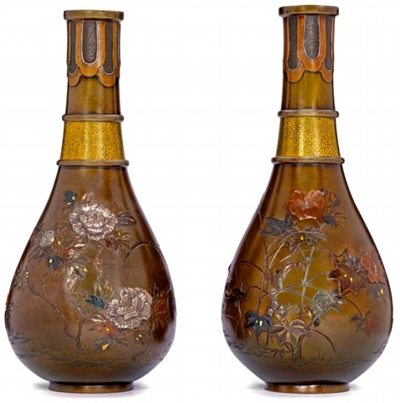 A pair of bronze and mixed metal vases
By Jomi Eisuke II (1839-1899), Meiji period (late 19th century)
Each globular with a tapering neck, set on a ring foot and decorated with flowering plants of the seasons in silver, gold, copper and shakudo inlays and carved on the surface in raised and sunken relief, the neck decorated with a band of gold "basketwork" and the collar with bands of lappets, the borders rendered in copper carved with key-frets and the interiors finished in ishime, signed on the foot in seal form Jomi sei and with kao
10 3/4in (27.3cm) high. Purchased at US$ 13,750 at Bonham on Sep 2013Jomi Eisuke 紹美栄祐 studied metalworking under the nineth-generation Kanaya Gorosaburo 金谷五郎三郎 and exhibited his works at many venues both Japan and overseas.
A pair of bronze and mixed metal vases
By Jomi Eisuke II (1839-1899), Meiji period (late 19th century)
Each globular with a tapering neck, set on a ring foot and decorated with flowering plants of the seasons in silver, gold, copper and shakudo inlays and carved on the surface in raised and sunken relief, the neck decorated with a band of gold "basketwork" and the collar with bands of lappets, the borders rendered in copper carved with key-frets and the interiors finished in ishime, signed on the foot in seal form Jomi sei and with kao
10 3/4in (27.3cm) high. Purchased at US$ 13,750 at Bonham on Sep 2013Jomi Eisuke 紹美栄祐 studied metalworking under the nineth-generation Kanaya Gorosaburo 金谷五郎三郎 and exhibited his works at many venues both Japan and overseas.
Jomi had two lines of work, medium and top quality, and had eighty-one workshops producing the medium-quality objects alone. The firm must have employed several hundred metalworkers.
Murata Seimin 村田整珉 (1761-1837)
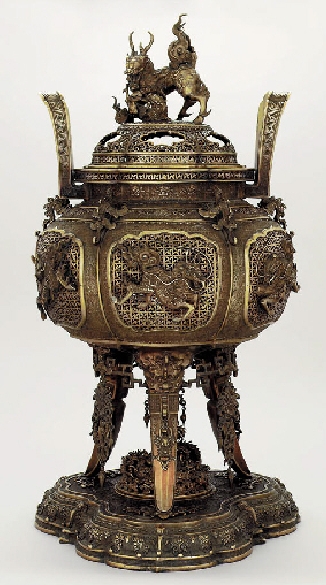 INCENSE BURNER signed Seimin, Late 19th Century. The flattened spherical six-lobed body with two large vertical handles and a projecting rim, supported on three tapering legs joined by keyfret stretchers with a pendant ornaments, the legs resting on a trilobate base with a central cavity with a lid carved as a dragon and clouds, the lid with six large openings surmounted by a horned shishi controlling its frolicking cub, the whole surface with intricate low-relief ornament and variously decorated with cloud, dragon and wave designs, each of the six sides of the body each with a lobed panel of openwork keyfret applied with a kirin, with six ho-o birds around the rim on the depressions between the lobes, with signature on the reverse of one of the legs Dainihon Bunsei-nen Seimin chu [cast by Seimin of great Japan in the Bunsei period (1818-30)
40in. (102cm.) high. Sold at £6,463 at Christie's on 20 June 2001.Murata Seimin (1761-1837) is the famous bronzecaster. His sign Seimin is routinely found on pieces of somewhat later date. For another example of a large bronze with a separate, detachable ornament in the centre of the base see Joe Earle, Splendors of Meiji: Treasures of Imperial Japan, Masterpieces from the Khalili Collection (St. Petersburg, Florida, Broughton International Publications, 1999), cat. no. 000
INCENSE BURNER signed Seimin, Late 19th Century. The flattened spherical six-lobed body with two large vertical handles and a projecting rim, supported on three tapering legs joined by keyfret stretchers with a pendant ornaments, the legs resting on a trilobate base with a central cavity with a lid carved as a dragon and clouds, the lid with six large openings surmounted by a horned shishi controlling its frolicking cub, the whole surface with intricate low-relief ornament and variously decorated with cloud, dragon and wave designs, each of the six sides of the body each with a lobed panel of openwork keyfret applied with a kirin, with six ho-o birds around the rim on the depressions between the lobes, with signature on the reverse of one of the legs Dainihon Bunsei-nen Seimin chu [cast by Seimin of great Japan in the Bunsei period (1818-30)
40in. (102cm.) high. Sold at £6,463 at Christie's on 20 June 2001.Murata Seimin (1761-1837) is the famous bronzecaster. His sign Seimin is routinely found on pieces of somewhat later date. For another example of a large bronze with a separate, detachable ornament in the centre of the base see Joe Earle, Splendors of Meiji: Treasures of Imperial Japan, Masterpieces from the Khalili Collection (St. Petersburg, Florida, Broughton International Publications, 1999), cat. no. 000
Seimin is chiefly known for his precise bronze sculpture using the lost-wax method. A cast is first made by modelling the statue in wax over a core. The wax model is then covered in clay which hardens to form a cast; the wax is melted away and molten bronze poured between clay and core and allowed to cool, after which most of the core is removed. Seimin cast the 500 arhats (disciples of the Buddha) at Kenchōji Temple in Kyoto.
L. Smith, V. Harris and T. Clark, Japanese art: masterpieces in (London, The British Museum Press, 1990)
Samurai Shokai 侍商会, Yokohama
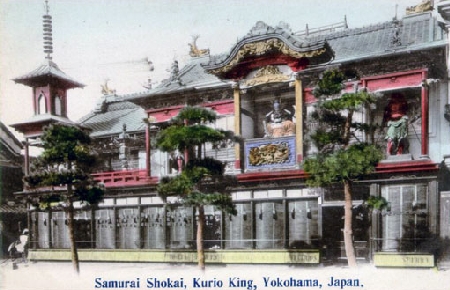 Front view of Samurai Shokai.Antique and art dealer Samurai Shokai at Honcho 1-20 in Yokohama, Kanagawa Prefecture. It sold silk, porcelain, lacquerware, jade, cloisonné, damascene and more.
Front view of Samurai Shokai.Antique and art dealer Samurai Shokai at Honcho 1-20 in Yokohama, Kanagawa Prefecture. It sold silk, porcelain, lacquerware, jade, cloisonné, damascene and more.
The company, established by Yozo Nomura (1870-1965) in 1894 (Meiji 27), was one of the most respected dealers in Japan. It even offered financial support to traditional craftsmen, such as silversmiths and lacquer artists, so they could produce high quality products.
Terry’s Guide to the Japanese Empire, published in 1920, features a glowing review:
An old established trustworthy house (highly spoken of) with one of the finest collections (second only in point of interest to the National Museum, at Tokyo) of curios and art objects in Japan. Recognised by antiquarians and art connoisseurs as headquarters for many of the beautiful products for which Japan is celebrated. The showrooms, filled with choice Japanese, Chinese and Korean carved furniture, porcelains, ivories, bronzes, brasses, silver pieces, damascene work, gold lacquer, mother-of-pearl inlays, tea-sets, chests, screens, brocades, silks; diamond, pearl, jade and other jewelry, etc., etc., rank among the city’s most interesting sights. English is spoken in all the departments. Prices are marked in plain figures, and there are no misrepresentations. Purveyors to the Imperial Japanese Household, and to the chief Museums of the world. Wholesale and retail. Manufacturers and exporters. Mail orders a specialty. Recommended.1
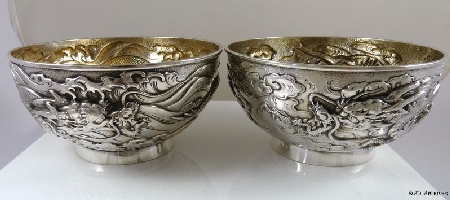 Dragon Cups, signed Samurai Shokai, Yokohama. Diameters: 12.2cm, height: 6.2cm, Weight: 118g. In 1923, three years after these words were published, this repository of Japanese art was burned to the ground in the Great Kanto Earthquake, but Nomura managed to rebuild his company and thrive.
Dragon Cups, signed Samurai Shokai, Yokohama. Diameters: 12.2cm, height: 6.2cm, Weight: 118g. In 1923, three years after these words were published, this repository of Japanese art was burned to the ground in the Great Kanto Earthquake, but Nomura managed to rebuild his company and thrive.
Nomura, whose wife was a Christian activist (he himself was Buddhist), made it his mission to introduce Japanese art and culture to the world. He was a well-travelled man and for example visited Hawaii annually where he met members of the influential Cooke family, good customers of Samurai Shokai. The Honolulu Academy of Arts to this day owns many pieces supplied to the Cookes by Nomura.
Later, Nomura would also become the owner of the New Grand Hotel in Yokohama. When on August 30, 1945, General MacArthur spent his very first night in Japan at the New Grand, he was welcomed by Nomura, then already 75 years old.
In spite of his old age and the many hardships he must have endured during WWII (Yokohama was almost completely destroyed by US air raids), he was still a master at treating an important customer.
 Box, signed Samurai Shokai, YokohamaIn The Fall of Japan, William Craig describes MacArthur’s first meeting with Nomura:
Box, signed Samurai Shokai, YokohamaIn The Fall of Japan, William Craig describes MacArthur’s first meeting with Nomura:
At the door of the New Grand Hotel, Yozo Nomura, an elderly Japanese dressed in a morning coat, waited nervously for the Supreme Allied Commander. When MacArthur arrived, he bowed and welcomed him. The General asked “How long have you been the manager of the hotel?” Nomura hastened to correct him. “I am not a manager. I am the owner. Welcome. I wish to offer my respects to you. During your stay, we'll do our very best to service you and I hope you'll like the room I'm going to show you.”2
MacArthur repaid Nomura's courtesy by showing much trust and insisting that his food was not pre-tasted. As recalled in Maihafer's Brave decisions, it was a compliment that Nomura took to heart:
That evening at the New Grand Hotel, MacArthur was served a steak dinner. As he started to eat, Whitney put a hand on his arm. “Better have someone taste that food, General. There’s a good chance it may be poisoned.”
MacArthur just laughed. “This is a good steak, and I don’t intend to share it with anyone!”
The hotel staff had also expected MacArthur to request a precautionary tasting. When he did not, Yozo Nomura, the hotel owner, came to the table to express gratitude for this expression of "great trust" saying he and his employees were "honored beyond belief".
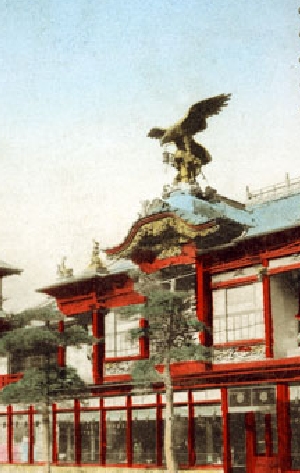 Front view of Samurai Shokai.Japan Today: A Souvenir of the Anglo-Japanese Exhibition Held in London 1910, published in 1910, features a brief introduction to Nomura that sheds some light on his background:
Front view of Samurai Shokai.Japan Today: A Souvenir of the Anglo-Japanese Exhibition Held in London 1910, published in 1910, features a brief introduction to Nomura that sheds some light on his background:
Visitors to Yokohama will find a large fine art and curio shop in the corner of Itchome, Honcho, and will be quite impressed with the splendor of the building. On stepping inside one will observe a huge image of Nio 仁王, the guardian god generally found in front of Buddhist temples. This is none other than the Samurai Shokwai which is known otherwise as the Fine Arts Museum of Yokohama. Gold, silver, and copper wares, pictorial lacquered wares, porcelains, ivory, wood carvings bags, and other objects of arts both old and new embellish this shop, so that it is sometimes mistaken for a public fine art museum. Visitors from all parts of the world are attracted to the Samurai Shokwai to make purchases, and the shop is crowded with foreign ladies and gentlemen.
The proprietor of the Samurai Shokwai is Mr. Yozo Nomura. Only a few decades have elapsed since the Samurai Shokwai was established, but owing to the business ability of its proprietor the firm has made wonderful progress. In front of the establishment is a sign board with gilded letters, "the King of Curios", indicating the high ambition Mr. Nomura's which has been deservedly realized. The store has grown to be the largest Fine Art Emporium in the Orient.
An observation of the career of this successful man at once shows that all was not smooth sailing for him. Mr. Nomura studied both in Keiogijiku and Waseda Universities, but he had to leave school before completing the regular courses. His ambition was to seek his fortune in foreign countries. He crossed over to America as an interpreter to a commissioner sent from the Central Tea Traders Association, but was separated from his friend there, which caused him many difficulties. It did not take him very long to discover splendid opportunities. It was just at this time that Mr. Charles Parson, one of the Railway Kings of America, sold the railway in his possession, and realized a profit of 3,000,000 dollars. Mr. Nomura urged him to cross over to Japan and make an investment in Japanese enterprises. In company with Mr. Parson, he came back to Japan where he became engaged in making a collection of fine art objects for him. It was at this time that he began to develop a taste for the trade.
He served in the capacity of clerk for a firm after his third return from Europe, where he was well treated but he was far from being satisfied with remaining there in such a limited position. Making up his mind to establish himself at his own cost, he resigned his post in the firm. Not- withstanding all his resolutions, he was handicapped financially, but after repeated efforts, he succeeded in borrowing two military bonds with a face value of one hundred yen each, which he had cashed thus realizing 170 yen. He rented a house in Itchome, Honcho, Yokohama, (which now forms a part of his present establishment) at a rent of 45 yen, and launched his project under the name, “Samurai Shokwai.” This was 15 years ago. When all the equipments were made in the way of electric lighting etc. there was left in his pocket the trifling sum of 7 yen 21 sen.
At first his business had necessarily to be on a small scale. He had to run about among his friends in order to borrow unsalable articles in order to embellish his own shop. At the beginning when the business was started, the proceeds for three days ran up to only ten yen. This deplorable state of affairs lasted for several months, but the saying that necessity is the mother of invention was amply illustrated in his case. Not long after, Mr. Morgan made a purchase of over 3,000 yen, and Mr. Yu, Chinese Minister to Japan, bought 2,000 yen worth of goods, which emboldened Mr. Nomura who was then on the verge of despondency. In connection with the Samurai Shokwai, Mr. Hodgeson, an Englishman who made a purchase of curios amounting to 100,000 yen through the hands of Mr. Nomura, must not be forgotten.
Honesty is the best business policy. Mr. Nomura is so accommodating to foreign visitors that they always feel assured that there will be no trouble arising in connection with transportation etc. if their purchases are taken to the Samurai Shokwai, where all this is attended to. Lastly, we must remember that Mr. Nomura was educated in the West, and that he is indebted for his present success to Mr. Baten Hall.
1 Terry, T. Philip (1920). Terry’s Guide to the Japanese Empire Including Korea and Formosa. Houghton Mifflin Company, 6.
2 Craig, William(1967). The fall of Japan. Dial Press, 294.
3 Maihafer, Harry J. (1999). Brave decisions: fifteen profiles in courage and character from American military history. Brassey’s, 160. ISBN 1574882074
4 Mochizuki, Kotaro (1910). Japan Today: A Souvenir of the Anglo-Japanese Exhibition Held in London 1910. The Liberal News Agency, 479.
Miyao Eisuke 宮尾栄助 (1868-1912)
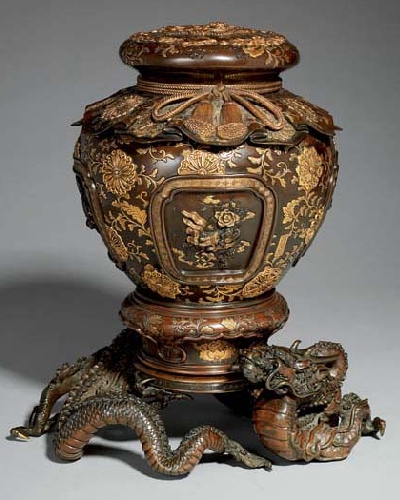 A BRONZE VASE AND COVER
signed Miyao Sei, late 19th century. Modelled as a cloth-covered jar on a coiled dragon, the dark brown patinated bronze decorated in high relief with panels of birds, a child chasing a butterfly, a squirrel among grapes and a bird on a lotus plant, bordered by chrysanthemums and scrolling foliage, 30.3cm. high. This was sold at $ 31,200 at Christie's Zurich on 19 February 2007.The Miyao company manufactured or dealt in a wide range of craft goods including large-scale bronze figures of samurai, Shibayama-work panels and ivory figures.
A BRONZE VASE AND COVER
signed Miyao Sei, late 19th century. Modelled as a cloth-covered jar on a coiled dragon, the dark brown patinated bronze decorated in high relief with panels of birds, a child chasing a butterfly, a squirrel among grapes and a bird on a lotus plant, bordered by chrysanthemums and scrolling foliage, 30.3cm. high. This was sold at $ 31,200 at Christie's Zurich on 19 February 2007.The Miyao company manufactured or dealt in a wide range of craft goods including large-scale bronze figures of samurai, Shibayama-work panels and ivory figures.
Joe Earle, Splendors of Meiji: Treasures of Imperial Japan, Masterpieces from the Khalili Collection (St. Petersburg, Florida, Broughton International Publications, 1999), pp. 95, 112-4
Apparently based first in Yokohama and then, after about 1890, in Nihonbashi-ku, Tokyo, the company is first recorded at the second Naikoku Kangyo Hakurankai [National Industrial Exposition] where Miyao Eisuke collaborated with the bronzecaster Momose Sozaemon in the production of a bronze figure of seven drunken shojo.
Tokyo Kokuritsu Bunkazai Kenkyujo [Tokyo National Research Institution of Cultural Properties], Naikoku kangyo hakurankai bijutsuhin shuppin mokuroku [Catalogs of objects exhibited at the National Industrial Expositions] (Tokyo, Chuokoron Bijutsu Shuppan, 1996), II 1163-4, 1176; IIIb 412, 632-3
 A BRONZE Okimon signed Miyao Sei, late 19th century.
A BRONZE Okimon signed Miyao Sei, late 19th century. 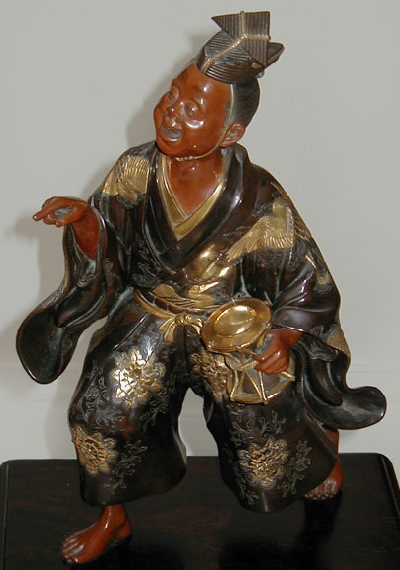 A BRONZE Okimon signed Miyao Sei, late 19th century.
A BRONZE Okimon signed Miyao Sei, late 19th century.
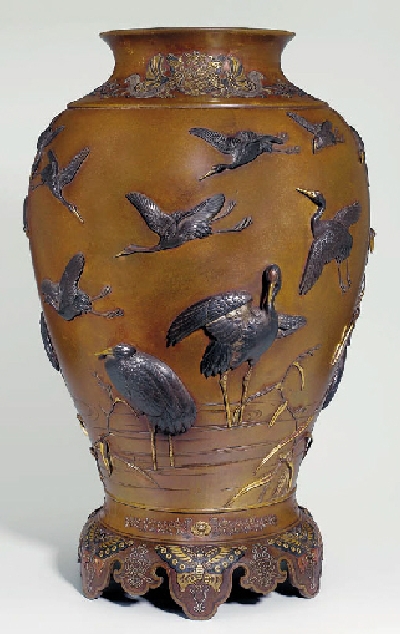 BRONZE VASE signed Miyao, Late 19th Century. With yellow-brown patination, the ovoid body with a short everted neck and integral base with six lappet-shaped feet, decorated in silver, gilding, shakudo [copper-gold alloy] and shibuichi [copper- silver alloy] high and applied relief with cranes in flight and bamboo on the body, below a band of low-relief confronted ho-o bird motifs and above a narrow band of floral ornament, the base with stylised butterflies and foliage, signed on the base Miyao with a seal 16¾in. (42.5cm.) high. Sold at £24,675 at Christie's on 20 June 2001.
BRONZE VASE signed Miyao, Late 19th Century. With yellow-brown patination, the ovoid body with a short everted neck and integral base with six lappet-shaped feet, decorated in silver, gilding, shakudo [copper-gold alloy] and shibuichi [copper- silver alloy] high and applied relief with cranes in flight and bamboo on the body, below a band of low-relief confronted ho-o bird motifs and above a narrow band of floral ornament, the base with stylised butterflies and foliage, signed on the base Miyao with a seal 16¾in. (42.5cm.) high. Sold at £24,675 at Christie's on 20 June 2001.
Takahashi Ryoun 高橋凌雲
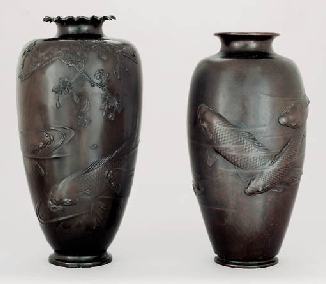 BRONZE VASE signed Ryoun, Meiji Period (1868-1912)
With dark brown patination, of elongated ovoid form with a short neck and out-turned rim, cast and chiselled in medium relief with four carp in a stream, a few details in gold, signed on the base in cast characters Ryoun. 21in. (53.2cm.) high. Sold at £1,880 at Christie's on 20 June 2001.Takahashi Ryoun exhibited a vase with this subject-matter at the Paris Exposition Universelle in 1900.
BRONZE VASE signed Ryoun, Meiji Period (1868-1912)
With dark brown patination, of elongated ovoid form with a short neck and out-turned rim, cast and chiselled in medium relief with four carp in a stream, a few details in gold, signed on the base in cast characters Ryoun. 21in. (53.2cm.) high. Sold at £1,880 at Christie's on 20 June 2001.Takahashi Ryoun exhibited a vase with this subject-matter at the Paris Exposition Universelle in 1900.
Tokyo Kokuritsu Bunkazai Kenkyujo [Tokyo National Research Institution of Cultural Properties], Meiji-ki bankoku hakurankai bijutsuhin shuppin mokuroku [Catalogs of objects exhibited at the international expositions in the Meiji period] (Tokyo, Chuokoron Bijutsu Shuppan, 1997), Q 107; see also Q 161, 175 and R 863
Kashima Ippu 鹿島一布 (1828-1900)
 A Magnificent Bronze and Iron Vase
Signed on an inset tablet Uchimono [hammer worker] Kurokawa Eisho, choko [sculptor] Kamijo Kazutoshi, zogan [inlay] Kashima Ippu and sealed Sawada sei, Meiji Period (late 19th century)
On four mask feet carved and engraved in gold, silver, shakudo and gilt with an eagle amongst pine on rocks beside a waterfall, the feathers finely detailed, the reverse with two red-capped cranes under cherry blossoms beside a stream, with two applied handles inlaid in gold with scrolling vines, the base with scrolling vines and mythical creatures in gilt inlay, the cover with a band of archaic motif of mythical creatures, with a finely detailed finial of a kirin, a ball in its mouth
51cm. high. Auctioned at Christies, May 2012, fetched £67,250.Kashima Ippu 鹿島一布 (鹿島一布齊楽則, 1828-1900), his name is Zenjiro 善次郎, learned Nunome-zogan 布目象眼 technique applied on Tsuba 鍔 made of ferrous from his father Kashima Ippusai Hidehiro 鹿島一布齊秀広. And later he also learned under Kashima Mitsuyuki 鹿島光幸.
A Magnificent Bronze and Iron Vase
Signed on an inset tablet Uchimono [hammer worker] Kurokawa Eisho, choko [sculptor] Kamijo Kazutoshi, zogan [inlay] Kashima Ippu and sealed Sawada sei, Meiji Period (late 19th century)
On four mask feet carved and engraved in gold, silver, shakudo and gilt with an eagle amongst pine on rocks beside a waterfall, the feathers finely detailed, the reverse with two red-capped cranes under cherry blossoms beside a stream, with two applied handles inlaid in gold with scrolling vines, the base with scrolling vines and mythical creatures in gilt inlay, the cover with a band of archaic motif of mythical creatures, with a finely detailed finial of a kirin, a ball in its mouth
51cm. high. Auctioned at Christies, May 2012, fetched £67,250.Kashima Ippu 鹿島一布 (鹿島一布齊楽則, 1828-1900), his name is Zenjiro 善次郎, learned Nunome-zogan 布目象眼 technique applied on Tsuba 鍔 made of ferrous from his father Kashima Ippusai Hidehiro 鹿島一布齊秀広. And later he also learned under Kashima Mitsuyuki 鹿島光幸.
He started to apply Nunome-zougan on the silver-cupped alloy (朧銀 rouging or oborogin) or various metals (色金 irogane) and draw the nature, animals, geometrical or scrolling arabesque patterns. He developed his own field as a master of nunomezogan in particular. He exhibited his Nunome-zogan techniques extensively at the third Naikoku Kankgyo Hakurankai 第3回内国勧業博覧会 (National Industrial Exposition) held in 1890.
His important works are a landscape plaque 朧銀山水図額 in the collection of Tokyo National Museum and a Gold and Silver Inlayed Octagonal Vase 金象嵌八角壺 in Royal Collection 宮内庁.
Tokyo Kokuritsu Bunkazai Kenkyujo [Tokyo National Research Institution of Cultural Properties], Naikoku kangyo hakurankai bijutsuhin shuppin mokuroku [Catalogs of objects exhibited at the National Industrial Expositions] (Tokyo, Chuokoron Bijutsu Shuppan, 1996), IIIb 292, 540, 605-6, 608, 674
For a large-scale example of his nunome [gold damascene] work see Kaneko Kenji, Meiji no soshoku kogei [Decorative art of the Meiji period], Taiyo, Bessatsu [Special issue] (Tokyo, Heibonsha, Summer 1990), p. 80
2nd Yeijiro Kashima 二代鹿嶋栄二郎 was a cousin of the much more celebrated Kajima Ippu, who was a metalworker in Tokyo, skilled in inlaying. Yeijiro's father 1st Yeijiro Kashima 初代鹿嶋栄二郎 of the same name produced some fine specimens of inlaid armor.
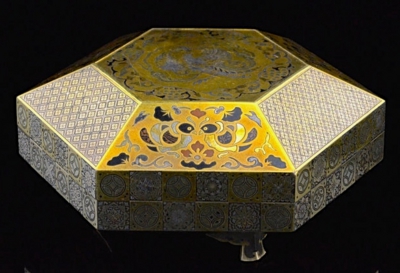 Inlayed Box singed 鹿島一布齊楽則 and Kaou 花押. 9.5cm x 11cm x 5.3cm
Inlayed Box singed 鹿島一布齊楽則 and Kaou 花押. 9.5cm x 11cm x 5.3cm
 Bronze Vase signed Ippu, Late Meiji Period, late-19th Century.
With pale yellowish-brown patination, cast in low-relief and engraved with a Pekingese wearing a ruff and playing with a buriburi [rolling toy] and a tasselled cord, the toy and other details embellished with gold, silver, shakudo [copper-gold alloy] and copper, signed near the foot in incised characters Ippu Koku [carved by Ippu] with a seal Mitsu
10 5/8in. (27cm.) high. Sold at £3,290 at Christie's on 20 June 2001.
Bronze Vase signed Ippu, Late Meiji Period, late-19th Century.
With pale yellowish-brown patination, cast in low-relief and engraved with a Pekingese wearing a ruff and playing with a buriburi [rolling toy] and a tasselled cord, the toy and other details embellished with gold, silver, shakudo [copper-gold alloy] and copper, signed near the foot in incised characters Ippu Koku [carved by Ippu] with a seal Mitsu
10 5/8in. (27cm.) high. Sold at £3,290 at Christie's on 20 June 2001.
Kasima Ikkoku 鹿島一谷 I / II (-1918) / III (1898-1996)
 Incense burner by 2nd Ikkoku Kashima, Meiji period, Sannenzaka Museum, Kyoto.Ikkoku Kashima III 三代目 鹿島一谷(1898-1996), true name is Yeiichi 栄一, was a ground son of Kashima Ikkoku I. He learned his family specialized technique of Nunome-zoga 布目象嵌 from his father and a grand father. And also he learned metal carving techniques 彫金 from Ichijyo Goto 後藤一乗、Kazuya Sekiguchi 関口一也、Shinya Sekiguchi 関口真也. He was designated a holder of an Important Intangible Cultural Property (the National Living Treasure 人間国宝) for his metal carving techniques in 1979.
Incense burner by 2nd Ikkoku Kashima, Meiji period, Sannenzaka Museum, Kyoto.Ikkoku Kashima III 三代目 鹿島一谷(1898-1996), true name is Yeiichi 栄一, was a ground son of Kashima Ikkoku I. He learned his family specialized technique of Nunome-zoga 布目象嵌 from his father and a grand father. And also he learned metal carving techniques 彫金 from Ichijyo Goto 後藤一乗、Kazuya Sekiguchi 関口一也、Shinya Sekiguchi 関口真也. He was designated a holder of an Important Intangible Cultural Property (the National Living Treasure 人間国宝) for his metal carving techniques in 1979.
Kashima Ikkoku II 鹿島一谷光敬 (-1918) who was appointed to the court of the Meiji Emperor as Imperial Artist, Teishitsu Gigeiin 帝室技芸員
Kashima Ikkoku I 鹿島一谷斎光敬
Kazuo Kashima 鹿島和生 (1958-), a grandson of 3rd Ikkoku Kashima, was adopted by him as his successor in 1978.
http://members3.jcom.home.ne.jp/k-kashima/top.html
Togi-dashi-Zogan 研出象嵌 invented by Kashima Ippu
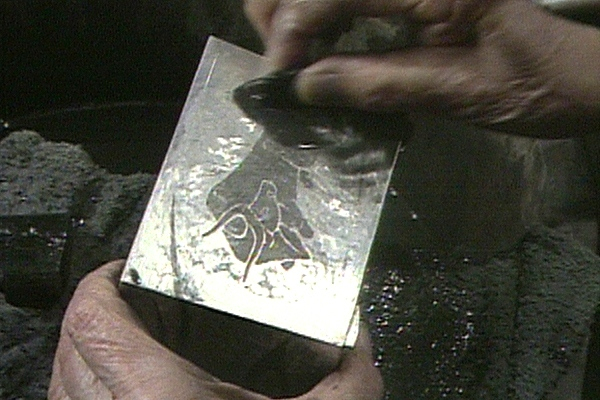 Togi-dashi operation by 3rd Ikkoku Kashima. His tutrial web site.Kashima Ikkoku's togi-dashi-zogan 研出象嵌 (ground-out inlaying) pieces, one is in in the Ashmolean museum in Oxford, England and two more in the Khallili collection, are possibly the most refined metalwork ever produced.
Togi-dashi operation by 3rd Ikkoku Kashima. His tutrial web site.Kashima Ikkoku's togi-dashi-zogan 研出象嵌 (ground-out inlaying) pieces, one is in in the Ashmolean museum in Oxford, England and two more in the Khallili collection, are possibly the most refined metalwork ever produced.
You can see the making process of Togi-dashi-Zogan by 3rd Ikkoku Kashima on this site. Certainly this process is his family original technique.
http://www2.edu.ipa.go.jp/gz2/y-kwm/y-gkg/y-ghn/IPA-tac490.htm
Captain F. Brinkley "Japan-Its History Arts and Literature" vol.8 page 315-316.
"...The most remarkable development of the process is seen in the togi-dashi-zogan (ground-out inlaying) invented by Kajima Ippu. In this exquisite and ingenious kind of work, the design appears to be growing up from the depths of the metal, and effects are produced which render it scarcely possible to believe that the picture has not been painted with the brush on some peculiarly receptive surface. As to the technique of togi-dashi-zogan, the metal — generally shibuichi — is first treated as though for nunome damascening, the principal and secondary design being carefully outlined. It is then passed through the furnace until it assumes a coppery hue, after which the design is overlaid with a thin film of ao-gin (specially prepared gold), which bites into nunome, and then with a wafer-like layer of silver. Next another equally slight coat of silver is beaten over the whole surface the result being that the design shows a faint golden hue in a silver field, the detail, however, not being discernible, and the picture looking as the the artist had roughly dashed in a rudimentary design with light-gold pigment. The next step is to hammer or punch the details of the design so as to emphasise them, and finally the expert procceds to polish the surface with strips of toishi (honing stone) bound together into a brush. The use of this peculiar instrument is tedious and demands delicate manipulation. Thus the various layers of metal are gradually ground down until the design emerge showing tints of all the metals employed — shibuichi, gold and silver. The shibuichi outlines assume the appearance of sepia drawing, and the general effect is that of a sepia picture in a silver field with a flush of gold looking out here and there. An impression of atmosphere and of water is obtained by this process with remarkable realism. Fishes appear to be swimming in silver water, some in the foreground, some in the background, and some in the middle distance, and so perfect is the illusion that the body of a fish is sometimes seen partially emerging, partially disappearing, in the silvery fluid ; flowers and Sprays appear glowing in sunlight ; birds best the air with their wings, and landscapes lie bathed in soft hazes. The process not only entails great labour, but also demands an exercise of skill which does not appear to be within reach of any of the artists of the present day except Kajima Ippu"
 Top
Top Site Map
Site Map References
References About Me
About Me